 |
 |
||||||||||
1s4p and 1s4s excitations
After
the removal of the exponential ansatz the prominent spectral feature
in the interval between 10 and 50 eV above the K edge is
disclosed as a resonance and an edge in close succession and a
compound edge further out (inset in Fig
5b). The energies are in
rough agreement
with DF estimates for [1s4p] and [1s4s] states. In Rb, the resonance
(A) is considerably wider than in Kr, more than expected from the
slight increase of the K vacancy lifetime width (2.75 eV in Kr,
2.99 eV in Rb [44]). Conversely, the adjacent
edge (B) is higher in Kr.
The compound [1s4s] edge (C) appears similar in both elements.
The picture becomes considerably clearer in the deconvoluted spectrum
of Kr (Fig 6a) where the striking similarity with Ar is demonstrated.
The same series of channels can be followed in both elements: a Fano
resonance (a0), a sharp resonance (a1,2) and a subsequent edge (a3),
a [1s4s] resonance (b1) and the edge (b2) with superposed diffuse structure.
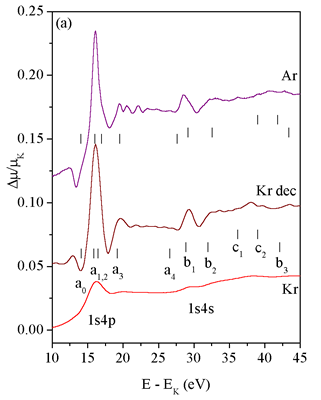 |
 |
| Fig. 6. Details of 1s4p and 1s4s MPE groups in Kr and Rb (below). Note the similarity of the deconvoluted spectra (middle) with the respective Ar and K 1s3p groups (above). Corrected HF excitation energies (see text) and labels in Table 3. The Ar and K data are shifted by 3.2 and 3.8 eV, respectively. | |
In Rb (Fig 6b), only a part of the natural width may be removed
by deconvolution due to a higher level of noise: so most of
the detail
remains hidden. The wide [1s4p] resonance reveals a composite structure,
comparable to that in the homologue K. The strength of the resonant
channel is larger than in Kr by a factor of 1.4: this value is
close to the corresponding factor of 1.5 for the 1s ![]() 5p
single-electron resonances at the K edge. The subsequent [1s4p]
edge is smaller
in Rb for a factor of 1.7.
5p
single-electron resonances at the K edge. The subsequent [1s4p]
edge is smaller
in Rb for a factor of 1.7.
The energy markers (a-c) in Fig 6(a,b) are obtained in a combined
HF-DF calculation where average multiplet energies from HF [45] are
corrected for the CI shifts from DF. The complete analogy with
Ar and K provides
the candidate coupling scheme and CI in the initial and final states
[16,17,27]. The prominent resonance is
a combination of [1s4p]5p^2 and [1s4p]4d^2 states (a1 and a2, respectively),
the latter accessible
from
the admixture of the [4p^2]4d^2 ground state by a single electron
transition 1s ![]() 4p.
In Kr, the two mixing multiplets occupy the same narrow energy
interval and form a sharp resonant peak. In Rb, the HF center of
gravity for 5p^2 lies almost 2 eV higher, and the resulting compound
resonance
is accordingly wider. The subsequent edge (a3) is predominantly
of [1s4p]5p character - it is the Rydberg limit of the[1s4p]5p^2
component
of the mixed (a1,a2) resonance. The other component has a Rydberg
daughter [1s4p^2]4d^2 5p at c1 and the continuum limit [1s4p^2]4d^2
at (c2).
4p.
In Kr, the two mixing multiplets occupy the same narrow energy
interval and form a sharp resonant peak. In Rb, the HF center of
gravity for 5p^2 lies almost 2 eV higher, and the resulting compound
resonance
is accordingly wider. The subsequent edge (a3) is predominantly
of [1s4p]5p character - it is the Rydberg limit of the[1s4p]5p^2
component
of the mixed (a1,a2) resonance. The other component has a Rydberg
daughter [1s4p^2]4d^2 5p at c1 and the continuum limit [1s4p^2]4d^2
at (c2).
The Fano resonance a0 at the low-energy side of the feature is
a fingerprint of the interaction of the Rydberg d series and continuum
d states admixed
to the 4d orbital in the weak [1s4p]5s4d transition.
In explanation of the [1s4s] resonance (b1), the agreement between
the experiment and the DF estimates is obtained after admixing
of appropriate [1s4p^2] excitations, as already demonstrated by
Dyall [46] for the
case of Ar [1s3s] feature. There, the mixing provided the necessary
-5 eV shift of the 1s3s resonant state. In Kr and Rb, the calculation
of the analogous mixing of [1s4s]5p5s and [1s4p^2]5s5p4d states
does not converge: the extrapolation of results from a series of
atoms with
augmented Z values gives a shift of -4.5 eV. The mixing ratio 2:1
is roughly the same as the 68:32 ratio reported for Ar. With a
similar
calculation, the subsequent edge is recognized as a mixed [1s4s]5s
+ [1s4p^2]5s4d state (b2), i.e. the promotion of the 1s electron
to a continuum p state, with the same coexcitation(s) as in the
resonance.
The definite presence of the 5s4d combination precludes the attractive
idea that the strong b1 peak and the subsequent b2 edge result
from another instance of a direct excitation from the ground state
admixture
[4p^2]4d^2, namely by a single electron transition 1s ![]() 5p
or 1s
5p
or 1s ![]() ep.
As already mentioned, their fingerprints are the resonance (c1)
and the
edge (c2) which lie considerably higher and do not mix with the
[1s4s]5p5s or [1s4s]5s state. However, the double vacancy [4p^2]
in the ground-state
admixture [4p^2]4d^2 as well as in the triple excitation [1s4p^2]5s4d
np is
ep.
As already mentioned, their fingerprints are the resonance (c1)
and the
edge (c2) which lie considerably higher and do not mix with the
[1s4s]5p5s or [1s4s]5s state. However, the double vacancy [4p^2]
in the ground-state
admixture [4p^2]4d^2 as well as in the triple excitation [1s4p^2]5s4d
np is ![]() ,
and so are both promoted pairs 4d^2 and 5s4d, respectively.
,
and so are both promoted pairs 4d^2 and 5s4d, respectively.
Table
3. Corrected HF energies (see text) of 4p and
4s coexcitations in Kr and Rb. |
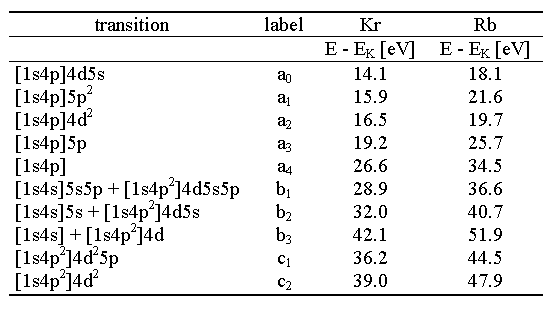 |
[1s3d] excitations
The relatively strong [1s3d] MPE group shows, on a finer scale, a lot
of detail modifying the basic shake profile (Fig. 7). The profile
includes a distinct shake-off component recognizable by its slow
saturation. Its total amplitude is approximately equal to the shake-up
edge amplitude, although the latter saturates in the span of the
natural width (a few eV) and the former in the range of the order
of MPE excitation energy, i.e. the binding energy of the coexcited
3d electron (50 and 60 eV in our shake-off model, for Kr and Rb,
respectively).
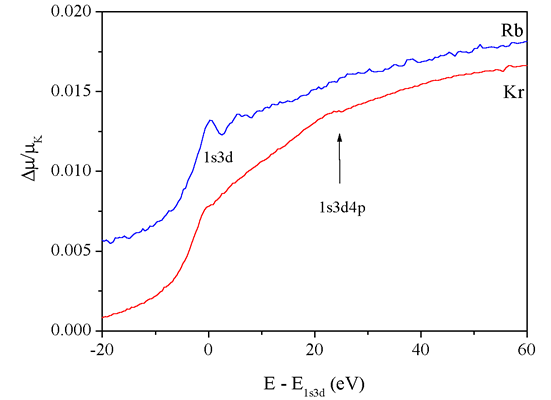 |
| Fig. 7. 3d coexcitations in Rb and Kr. The origin of energy scale is shifted to the position of the leading1s3d peak. The position of triple 1s3d4p excitation is indicated. |
The leading resonance in the d coexcitation has been shown to maintain
a fixed ratio to the K-edge resonance: the relation has been followed
in the 4d MPE features from xenon far into the lanthanide series
[22,24,25]. The 1s3d resonances in
Kr and Rb in Fig.7 also seem to keep the relation
of the respective resonant 1s ![]() 5p
excitations at the K-edge. The observation is supported by the absorption
spectrum of Rb+ ion in an aqueous
solution of RbNO3 [31,47]. There,
the 3d peak is stronger and wider than the
3d peak in the Rb vapor spectrum, in the same way as the prominent
1s
5p
excitations at the K-edge. The observation is supported by the absorption
spectrum of Rb+ ion in an aqueous
solution of RbNO3 [31,47]. There,
the 3d peak is stronger and wider than the
3d peak in the Rb vapor spectrum, in the same way as the prominent
1s ![]() 5p
white line in the ion spectrum is stronger and wider than the Rb
vapor 1s
5p
white line in the ion spectrum is stronger and wider than the Rb
vapor 1s ![]() 5p
resonance. The empirical finding may have a simple explanation: if
the core excitation (1s
5p
resonance. The empirical finding may have a simple explanation: if
the core excitation (1s ![]() np)
and the coexcitation (d
np)
and the coexcitation (d ![]() d)
do not involve the same orbitals, the transition matrix element factorizes
(to a
good approximation) so that the strength of the coexcitation
follows the
strength of the single-electron excitation at the edge.
d)
do not involve the same orbitals, the transition matrix element factorizes
(to a
good approximation) so that the strength of the coexcitation
follows the
strength of the single-electron excitation at the edge.
The Rb spectrum provides an additional puzzle: the 1s3d resonance
is recognizably split. The splitting of 6 eV, however, does not readily
suggest what states might be involved: the ![]() splitting
is
much smaller. The analysis of the [1s3d]5p4d multiplet with the total
spread of 9.1 eV shows a dense group between 0 and 4.5 eV, and two
separate levels, at 7.2 and 9.1 eV in almost pure LS coupling of
[3d]4d
splitting
is
much smaller. The analysis of the [1s3d]5p4d multiplet with the total
spread of 9.1 eV shows a dense group between 0 and 4.5 eV, and two
separate levels, at 7.2 and 9.1 eV in almost pure LS coupling of
[3d]4d ![]() . The direct promotion of the d electron may give these
levels a
larger cross section, so that they show up in comparable strength
to the large group below 4.5 eV where all levels involve d promotion
with
a nonzero change of angular momentum.
. The direct promotion of the d electron may give these
levels a
larger cross section, so that they show up in comparable strength
to the large group below 4.5 eV where all levels involve d promotion
with
a nonzero change of angular momentum.
In Kr, the spread of the multiplet is only one half that of Rb, with
the two direct-promotion levels at 4.6 and 4.7 eV. The effective
width of the group is thus below 3.5 eV, forming a single peak in
the 3 eV
natural width spectrum. The observed difference in the widths of
the multiplet between the two elements can thus be ascribed to the
imminent
collapse of the 4d orbital: Rb[1s3d] with two core vacancies is already
on the other side of the collapse threshold. The shake-up multiplets
[1s3d]4d show analogous splitting as the respective resonant multiplets.
In the shake-off multiplets [1s3d], which involve no 4d orbital,
there is a single tight group of levels.
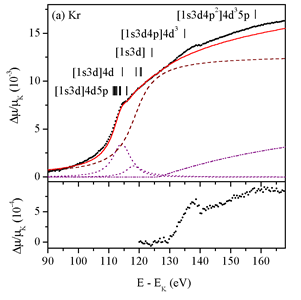 |
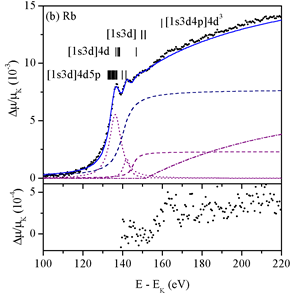 |
| Fig. 8. Model components of the Kr and Rb 1s3d group: resonant (dots), shake-up (dashes) and shake-off (dash-dots) two-electron channels. The residual (below) indicates the presence of tri- and perhaps even four-electron excitations. DF multiplets and HF levels are shown. Note the similarity of the residuals to the respective 1s4p structures in Fig. 4. | |
The flat rise of the cross section above the resonance in both
elements is a superposition of the shake-off profile and a
small hump 25 eV
above the 3d threshold. In Kr, the hump has been ascribed to a
triple vacancy state [7] without identification
of reaction channels. Fig.
8 shows the sum of two-electron excitation components of our model:
the residual in Kr resembles the profile of the 1s4p/4s group.
It comprises a resonance and an edge, with energies close to
the [1s3d4p]4d^3
and
[1s3d4p]4d^2, respectively, and possibly a shake-off component.
The similarity with the 1s4p/4s group is apparent also in Rb,
in spite
of larger noise level. The unusual strength of the triple excitation
can again be explained as a transition from the [4p^2]4d^2 component
of the ground state whence two electrons are promoted: 1s ![]() 4p
accompanied by either 3d
4p
accompanied by either 3d ![]() 4d
or 3d
4d
or 3d ![]() ed.
In the sharper Kr spectrum, the removal of the double-vacancy components
from the 1s3d feature even reveals
a
tiny Rydberg daughter 1s
ed.
In the sharper Kr spectrum, the removal of the double-vacancy components
from the 1s3d feature even reveals
a
tiny Rydberg daughter 1s ![]() 5p
belonging, formally, to a quadruple vacancy state [1s3d4p^2]!
5p
belonging, formally, to a quadruple vacancy state [1s3d4p^2]!
[1s3p]
and [1s3s] excitations
The 1s3p feature is recognized as a distinct break of slope 240 and
270 eV above the K edge of Kr and Rb, respectively, close to the
DF energy estimates. Pure contribution of the [1s3p] channels is
revealed after a careful elimination of the [1s3d] shake-off upon
which it is superposed. The long saturation profile points to a predominant
shake-off character. Yet the vestiges of a structure immediately
above the threshold reliably define also a resonant and a shake-up
contribution, both in a doublet with a splitting of approximately
8.5 and 10 eV for Kr and Rb, respectively (Fig. 9). The splitting
is induced by the ![]() subshell
structure which remains the main feature of the multiplets in spite
of coupling with 1s and
excitation orbitals.
subshell
structure which remains the main feature of the multiplets in spite
of coupling with 1s and
excitation orbitals.
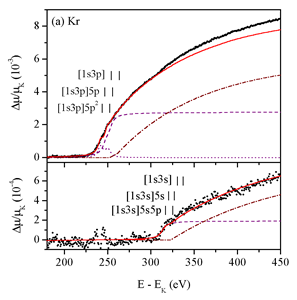 |
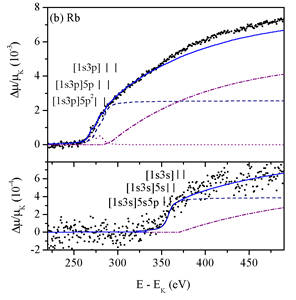 |
| Fig. 9. Model components of the 1s3p and 1s3s group in Kr and Rb. Channels of the 1s3p group are subtracted to show the 1s3s group as a residual. It is only decomposed into a single shake-up and shake-off component due to the large noise. | |
A small [1s3s] feature can be resolved in the residue after subtraction
of the [1s3p] model components from the experimental spectrum. The
feature in Kr is revealed as a small and broad absorption edge close
to the energy of the Dirac-Fock estimate. A similar edge is recognized
in Rb in spite of larger noise. This is the deepest MPE observed
so far. As in the case of [1s3p], the feature is a combination
of a [1s3s]
shake-up and shake-off channel. The large width is partly due to
the 6 eV singlet-triplet splitting of the [1s3s] vacancy pair,
and partly
due to the intrinsic lifetime width, the sum of the [1s] and [3s]
widths. The model amplitude of the shake-off transition is
strongly coupled
with the parameters of the [1s3p] shake-off upon which the feature
is superposed.
Among earlier discussions of Kr MPE spectrum, Deutsch &Hart [3,4] identified all subshell groups and their main features. The [1s3s]
feature in their report [3] appears within 5 eV of ours. The estimated
amplitudes of the shake-up and shake-off exceed ours by a factor of
2.
|
|
|||||||||||||||||||||||||||||||||||||||||||||||||||||||||||
|
E-mail:iztok.arcon@p-ng.si Last change: 28-Jun-2006 |
|||||||||||||||||||||||||||||||||||||||||||||||||||||||||||